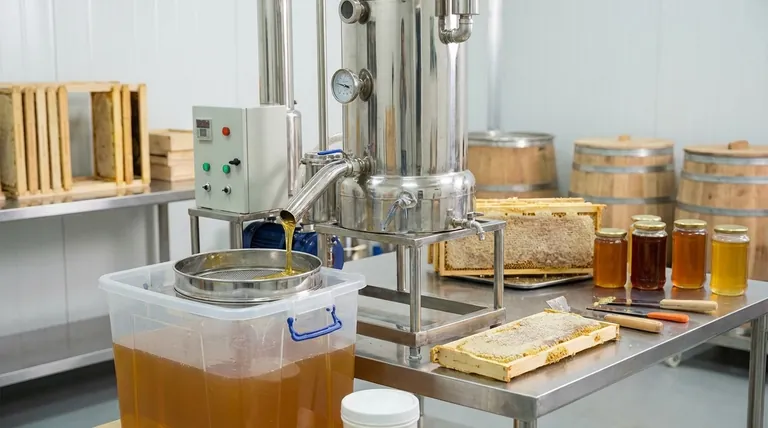Yes, honey can be filtered. This common practice is used to remove physical impurities such as wax, bee parts, and other hive debris. The process results in the clear, smooth honey many consumers expect and does not remove the nectar or make the honey any less real or natural.
The core issue is not whether honey is filtered, but how it is filtered. Standard filtration is a simple purity step, whereas a more aggressive process called ultrafiltration can remove beneficial pollen, which is a key marker of the honey's origin.

What Does Filtering Honey Actually Accomplish?
Filtering is a quality control step that primarily addresses the purity, texture, and shelf-life of honey. It's a standard part of both artisanal and commercial honey processing.
Removing Physical Impurities
The most basic purpose of filtering is to create a clean product. During extraction, it's inevitable that small particles from the hive—like bits of beeswax, propolis, and even bee parts—will get mixed in with the honey.
Filtering ensures these unwanted materials are removed before the honey is bottled.
Improving Clarity and Texture
Consumers often associate high-quality honey with a perfectly clear, liquid appearance. Filtering helps achieve this by removing not just large debris but also fine suspended particles.
This process also helps slow down crystallization. Tiny particles of pollen and wax can act as "seeds" for sugar crystals to form around, and removing them helps the honey remain liquid for longer.
The Critical Difference: Filtration vs. Ultrafiltration
The confusion around filtered honey often stems from a failure to distinguish between two very different processes.
Standard filtration uses a mesh to catch physical debris. This is a benign process that clarifies the honey.
Ultrafiltration, on the other hand, is a high-pressure industrial process that pushes honey through an extremely fine filter. This can strip out nearly all of the pollen, which is a key component for identifying the honey's floral and geographical source.
Understanding the Trade-offs
Choosing between filtered and unfiltered honey involves understanding what is gained and what is potentially lost in the process.
The Benefit: Purity and a Longer Liquid State
The primary upside of filtered honey is clear: you get a pure product free of hive debris.
For those who prefer their honey to remain a smooth liquid for cooking or table use, filtered honey is often the more practical choice due to its slower rate of crystallization.
The Potential Downside: Loss of Pollen
While the absence of pollen does not reduce the core benefits of honey, pollen is valuable for one key reason: traceability. Experts can analyze the specific pollen in a sample of honey to verify its botanical and geographical origin.
Some large-scale producers may use ultrafiltration to obscure the honey's country of origin, which is a source of controversy in the industry.
The "Real" vs. "Natural" Debate
Filtered honey is absolutely real honey. The process simply removes foreign matter. It's no different than filtering water or apple cider to improve their clarity and quality.
The debate arises when ultrafiltration is used to remove the very essence of the honey's identity—its pollen signature. However, for most honey on the shelf, standard filtration is the norm.
Making the Right Choice for Your Needs
Your preference for filtered or unfiltered honey should be based on your specific goals and what you value most in the product.
- If your primary focus is clarity and a smooth texture for everyday use: A standard filtered honey is a perfect, natural choice that will stay liquid longer in your pantry.
- If your primary focus is tracing the honey's exact floral and geographic source: Look for "unfiltered" or "raw" honey, as the pollen content provides this unique fingerprint.
- If your primary focus is large-scale commercial production: Specialized equipment like a honey press filter is essential for efficiently separating honey and beeswax at volume.
Ultimately, choosing filtered or unfiltered honey is a matter of personal preference, not a question of purity or naturalness.
Summary Table:
| Filtration Type | Primary Goal | Effect on Pollen | Ideal For |
|---|---|---|---|
| Standard Filtration | Remove wax, bee parts, debris | Minimal to no loss | Clear, smooth honey for everyday use |
| Ultrafiltration | Extreme clarity, obscuring origin | Removes nearly all pollen | Large-scale commercial operations |
| Unfiltered/Raw | Preserve all natural components | Full pollen content retained | Traceability, artisanal products |
Scale Your Honey Production with the Right Equipment from HONESTBEE
For commercial apiaries and beekeeping equipment distributors, efficient honey processing is key to profitability. The right filtration system ensures a high-quality, market-ready product while maximizing your yield.
HONESTBEE supplies durable, wholesale-focused beekeeping supplies and equipment—including honey press filters and extraction systems—designed for volume and reliability.
Let us help you optimize your operation. Contact our expert team today to discuss the best equipment solutions for your commercial needs.
Visual Guide

Related Products
- Honey Concentrating Vacuum Heating Thickening Machine Dehumidifier for Honey
- Professional Thermostatic Conical Honey Melter
- 0.5T Capacity Honey Dehumidifier Dryer with Vacuum Heating and Thickening Filtering Machine
- High Quality Honey Dehumidifier Dryer Thickening Machine for Beekeeping
- Inverted Squeezable Honey Jar with No Drip Flip Top Cap for Easy Pouring
People Also Ask
- What additional functions does a honey vacuum thickener have? Achieve a Stable, Commercial-Grade Product
- What is required for the cooling system when using circulating water in the honey vacuum thickener? Essential Components for Efficient Processing
- What are the main components of the honey vacuum thickener equipment? A Guide to Preserving Honey Quality
- Why is 304 stainless steel used in honey processing? Protect Your Honey's Purity & Flavor
- What are the benefits of motorized honey extractors? Save Time & Labor in Your Apiary



















